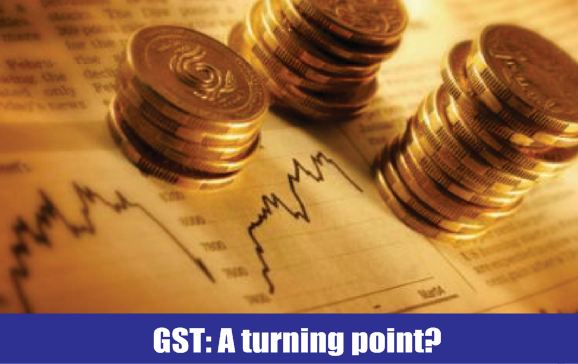
GST: A turning point?
- जुलाई 20, 2021
- 0
The recent upsurge in revenues offers the prospect of the country breaking out of the long-stagnant tax-to-GDP ratio
For the last 25 years, our tax-to-GDP ratio has been stuck at between 16 and 17 per cent, severely constraining our fiscal capacity to devote more resources to our underinvested sectors such as education and health. The State in a large country like India cannot discharge its developmental function with such a low fiscal capacity.
Even at our levels of per capita income, we should be nearer to a 20 per cent tax-to-GDP ratio given the norms of other emerging market economies.
There is no doubt that the recent uptick in GST revenues is largely due to better compliance prodded by the matching of invoices and better monitoring of permissions granted for registrations through physical verification of the premises and evaluation of the past income tax payment record. This has reduced the volume of fake input invoices. One indicator would be the cash-to-credit ratio of the duty paying units. A rough back of the envelope calculation shows that every month the GST duty payable amount is about Rs. 5 trillion, of which Rs. 4 trillion is paid through credit and Rs. 1 trillion in cash. This makes for a cash-to-credit ration of 20:80. There is now reason to believe that the improved compliance has pushed the cash component ration from 20 per cent to about 25 per cent yielding and additional monthly revenue of Rs. 25,00 crore. This is the reason why our new normal of GST revenues is Rs. 1.25 trillion instead of the earlier Rs. 1 trillion. This improvement needs a careful study.
The other gains in revenues have come from the personal income tax collection. Better coordination between the two tax departments- Central Board of Direct Taxes and Central Board of Indirect Taxes and Customs – has helped boost collections.
What has been especially useful is the declaration of the GST turnover in the income tax return, which has made revenue coordination possible. This has led to smaller units covering the unincorporated and the family units to pay greater amount of taxes. As the revenues paid by these units reflect in the personal income tax revenues, this category is showing better revenues and holding up even during this difficult Covid period. While better compliance has contributed to buoyancy in GST revenues, there is still work to be done.
First of all, the large number of exemptions need to be phased away. When GST was implemented there were 90+ State VAT exemptions and about 390+ Central excise exemptions. We need to restrict GST exemptions only to those items that were VAT exempt in the pre-GST period. This was the consensus reached by the Centre and the states in the various committees created.
In conclusion, the recent upsurge in GST revenue nudged up by better compliance, can be sustained by rate changes to increase the incidence of GST duty to a revenue neutral level of 14 per cent. This offers the prospect of the country breaking out of the “Fiscal chakravayuh” of 16-17 per cent of GDP in the medium term. Meanwhile, the buoyancy in the GST revenues can sustain higher healthcare expenditures in the short run, which welcome indeed.
Courtesy : VS Krishnan
बदलाव का वाहक बनने को तैयार जीएसटी
राजस्व में हुआ हालिया इजाफा यह संभावना पैदा करने वाला है कि देश कर-जीडीपी अनुपात के लंबे समय से चले आ रहे स्थिरता के दौर को समाप्त कर आगे बढ़ सकता है।
बीते 25 वर्षों से हमारा कर जीडीपी अनुपात 16-17 फीसदी के बीच अटका रहा है। इसके चलते कम निवेश वाले क्षेत्रों मसलन शिक्षा और स्वास्थ्य की मदद कर पाने की हमारी राजकोषीय क्षमता काफी प्रभावित हुई है। भारत जैसे बड़े देश में सरकार इतनी कम राजकोषीय क्षमता के साथ विकास संबंधी कार्य नहीं कर सकती। हमारे स्तर की प्रति व्यक्ति आय के साथ कर-जीड़ीपी अनुपात करीब 20 फीसदी होना चाहिए। उभरते बाजारों के मानक तो यहीं कहते हैं।
इसमें दो राय नहीं कि जीएसटी राजस्व में हालिया इजाफा इनवाॅइस के मिलान के कारण बेहतर हुए अनुपालन और परिसर के भौतिक सत्यापन तथा आयकर भुगतान के अतीत के रिकाॅर्ड के आकलन के बाद पंजीयन की इजाजत की बेहतर निगरानी की वजह से हुआ है। इससे फर्जी इनपुट इनवाॅइस के मामले कम हुए हैं। इसका एक संकेतक होगा शुल्क चुकाने वाली इकाइयों का नकदी ऋण अनुपात। एक मोटा-मोटा अनुमान बताता है कि हर महीने जीएसटी शुल्क चुकाए जाने लायक राशि करीब 5 लाख करोड़ रुपये होती है। इसमें से 4 लाख करोड़ रुपये की राशि उधार के जरिये और एक लाख करोड़ रुपये की राशि नकद चुकाई जाती है। यानी नकदी ऋण अनुपात 20ः80 रहता है। अब यह मानने की वजह है कि अनुपालन में सुधार से नकद हिस्सेदारी को 20 प्रतिशत से बढ़ाकर 25 प्रतिशत कर दिया है और इससे 25,000 करोड़ रुपये का अतिरिक्त मासिक राजस्व हासिल हो रहा है। यही कारण है कि जीएसटी राजस्व का हमारा नया सामान्य आंकड़ा 1.25 लाख करोड़ रुपये है जबकि पहले यह एक लाख करोड़ रुपये था। इस सुधार का बारीकी से अध्ययन किया जाना चाहिए।
राजस्व में दूसरा लाभ व्यक्तिगत आय कर संग्रह से आया है। केंद्रीय प्रत्यक्ष कर बोर्ड तथा केंद्रीय अप्रत्यक्ष कर एवं सीमा शुल्क बोर्ड के बीच बेहतर तालमेल ने संग्रह बढ़ाने में मदद की है। आयकर रिटर्न में जीएसटी टर्नओवर की घोषणा बहुत उपयोगी साबित हुई है। इससे राजस्व समन्वय संभव हुआ है। इसके कारण छोटी इकाइयां दायरे में आईं और पारिवारिक इकाइयों का कर भुगतान बढ़ा। इन इकाइयों द्वारा चुकाया जाने वाला कर व्यक्तिगत आय कर राजस्व में नजर आता है और इस श्रेणी का राजस्व सुधर रहा है। यहां तक की कोविड के कठिन दौर में भी यह बरकरार रहा। बेहतर अनुपालन ने जहां जीएसटी राजस्व सुधारने में मदद की, वहीं अभी भी कई कदम उठाए जाने की जरूरत है।
सबसे पहले बड़ी तादाद में दी जाने वाली रियायतों को चरणबद्ध तरीके से समाप्त करने की जरूरत है। जब जीएसटी लागू किया गया था तब राज्य मूल्यवर्धित कर में 90 से अधिक रियायते थीं जबकि केंद्रीय उत्पाद की रियायतों की तादाद 390 से अधिक थी। हमें जीएसटी रियायतों को उन वस्तुओं तक सीमित करने की आवश्यकता है जिन्हंे जीएसटी से पहले की अवधि में वैट रियायत हासिल थी। केंद्र और राज्यों विभिन्न समितियां इसी सहमति पर पहुंची।
निष्कर्ष यही निकलता है कि जीएसटी राजस्व में हाल में आई तेजी के लिए बेहतर अनुपालन वजह है लेकिन दरों में बदलाव के माध्यम से इसे स्थायी बनाया जा सकता है और 24 फीसदी की राजस्व पूर्ति दर तक ले जाया जा सकता है। ऐसे में यह संभावना भी बनती है कि भारत मध्यम अवधि में जीड़ीपी के 16-17 फीसदी के चक्रव्यूह को तोड़ सके। इस बीच जीएसटी राजस्व में आने वाली तेजी, अल्पावधि में स्वास्थ्य क्षेत्र में होने वाले उच्च व्यय को झेल सकती है जो अपने आप में बहुत बेहतर बात है।
































































